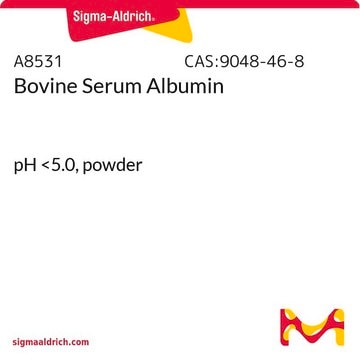A7517
Bovine Serum Albumin
For use as a marker in SDS-PAGE
Synonym(s):
Albumin bovine serum, BSA, Bovine albumin
About This Item
Recommended Products
biological source
bovine
Quality Level
Assay
24-32 mg/vial (biuret)
form
lyophilized powder
mol wt
~66 kDa
purified by
cold ethanol fractionation
packaging
vial of 25 mg
origin
USA origin
technique(s)
electrophoresis: suitable
pH
5.2
solubility
water: slightly soluble
suitability
suitable for (Suitable for use as an electrophoresis marker)
UniProt accession no.
storage temp.
2-8°C
Gene Information
bovine ... ALB(280717)
Looking for similar products? Visit Product Comparison Guide
General description
Application
- as a standard protein in the elution-filter aided proteome preparation (FASP) method and in sodium dodecyl sulfate-polyacrylamide gel electrophoresis(SDS-PAGE)
- as a component of the molecular weight marker in SDS-PAGE and western blotting
- as a blocking agent in immunofluorescence
Biochem/physiol Actions
Preparation Note
Storage Class Code
11 - Combustible Solids
WGK
WGK 3
Flash Point(F)
Not applicable
Flash Point(C)
Not applicable
Personal Protective Equipment
Choose from one of the most recent versions:
Certificates of Analysis (COA)
Don't see the Right Version?
If you require a particular version, you can look up a specific certificate by the Lot or Batch number.
Already Own This Product?
Find documentation for the products that you have recently purchased in the Document Library.
Customers Also Viewed
Our team of scientists has experience in all areas of research including Life Science, Material Science, Chemical Synthesis, Chromatography, Analytical and many others.
Contact Technical Service







